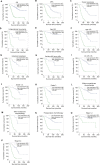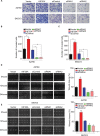Overexpression of kinesin family member 20A is associated with unfavorable clinical outcome and tumor progression in epithelial ovarian cancer
- PMID: 30254487
- PMCID: PMC6140728
- DOI: 10.2147/CMAR.S169214
Overexpression of kinesin family member 20A is associated with unfavorable clinical outcome and tumor progression in epithelial ovarian cancer
Abstract
Background: KIF20A plays an indispensable role in cytokinesis regulation, which is important for tumor proliferation and growth. Recently, the oncogenic role of KIF20A has been well documented in several cancers. However, its clinical role in epithelial ovarian cancer (EOC) remains not reported yet. We investigated its expression and its role in promoting invasion and chemoresistance in EOC cells.
Patients and methods: KIF20A transcription and translation levels were investigated in normal ovarian epithelial cell, ovarian cancer cells, and 10 pairs of fresh EOC tissues and adjacent normal ovarian tissues by real-time quantitative polymerase chain reaction and Western blots. Moreover, KIF20A protein level was also examined by immunohistochemistry in 150 EOC tissues. The correlation between KIF20A expression and clinical variables was analyzed by statistical methods. We also used wound healing assay, transwell assay MTT, and Annexin V/PI to explore KIF20A functions.
Results: KIF20A expression was obviously elevated at both mRNA and protein levels in EOC cell lines and clinical cancer tissues compared with normal ovarian epithelial cell and adjacent normal ovarian tissues. KIF20A protein expression was highly correlated with International Federation of Gynecology and Obstetrics stage (P=0.008), lymph node metastasis (P=0.002), intraperitoneal metastasis (P<0.001), vital status at last follow-up (P<0.001), intraperitoneal recurrence (P=0.030), tumor recurrence (P=0.005), drug resistance (P=0.013), and ascites with tumor cells (P<0.001). KIF20A overexpression was closely related to poorer overall survival and disease progression-free survival. Furthermore, Cox regression analysis revealed that KIF20A can act as an independent hazard indicator for predicting clinical outcomes in EOC patients. Interestingly, KIF20A overexpression promoted invasion and metastasis of EOC cells and also confers resistance to cisplatin.
Conclusion: Our findings indicated that KIF20A overexpression predicts unfavorable clinical outcome, revealing that KIF20A holds a promising potential to serve as a useful prognostic biomarker for EOC patients.
Keywords: KIF20A; clinical prognosis; epithelial ovarian cancer; tumor progression.
Conflict of interest statement
Disclosure The authors report no conflicts of interest in this work.
Figures






Similar articles
-
Expression, regulating mechanism and therapeutic target of KIF20A in multiple cancer.Heliyon. 2023 Jan 25;9(2):e13195. doi: 10.1016/j.heliyon.2023.e13195. eCollection 2023 Feb. Heliyon. 2023. PMID: 36798768 Free PMC article. Review.
-
Overexpression of Kinesin Family Member 20A Correlates with Disease Progression and Poor Prognosis in Human Nasopharyngeal Cancer: A Retrospective Analysis of 105 Patients.PLoS One. 2017 Jan 12;12(1):e0169280. doi: 10.1371/journal.pone.0169280. eCollection 2017. PLoS One. 2017. PMID: 28081138 Free PMC article.
-
High Expression of KIF20A Is Associated with Poor Overall Survival and Tumor Progression in Early-Stage Cervical Squamous Cell Carcinoma.PLoS One. 2016 Dec 12;11(12):e0167449. doi: 10.1371/journal.pone.0167449. eCollection 2016. PLoS One. 2016. PMID: 27941992 Free PMC article.
-
Upregulation of centrosomal protein 55 is associated with unfavorable prognosis and tumor invasion in epithelial ovarian carcinoma.Tumour Biol. 2016 May;37(5):6239-54. doi: 10.1007/s13277-015-4419-6. Epub 2015 Nov 28. Tumour Biol. 2016. PMID: 26615423 Free PMC article.
-
The Role of the Adipokine Resistin in the Pathogenesis and Progression of Epithelial Ovarian Cancer.Biomedicines. 2022 Apr 16;10(4):920. doi: 10.3390/biomedicines10040920. Biomedicines. 2022. PMID: 35453670 Free PMC article. Review.
Cited by
-
Genome‑wide investigation of the clinical significance and prospective molecular mechanisms of kinesin family member genes in patients with lung adenocarcinoma.Oncol Rep. 2019 Sep;42(3):1017-1034. doi: 10.3892/or.2019.7236. Epub 2019 Jul 16. Oncol Rep. 2019. PMID: 31322267 Free PMC article.
-
Expression, regulating mechanism and therapeutic target of KIF20A in multiple cancer.Heliyon. 2023 Jan 25;9(2):e13195. doi: 10.1016/j.heliyon.2023.e13195. eCollection 2023 Feb. Heliyon. 2023. PMID: 36798768 Free PMC article. Review.
-
Low expression of KIF20A suppresses cell proliferation, promotes chemosensitivity and is associated with better prognosis in HCC.Aging (Albany NY). 2021 Sep 6;13(18):22148-22163. doi: 10.18632/aging.203494. Epub 2021 Sep 6. Aging (Albany NY). 2021. PMID: 34491228 Free PMC article.
-
KIF20A Affects the Prognosis of Bladder Cancer by Promoting the Proliferation and Metastasis of Bladder Cancer Cells.Dis Markers. 2019 Apr 9;2019:4863182. doi: 10.1155/2019/4863182. eCollection 2019. Dis Markers. 2019. PMID: 31093305 Free PMC article.
-
Target Selection for T-Cell Therapy in Epithelial Ovarian Cancer: Systematic Prioritization of Self-Antigens.Int J Mol Sci. 2023 Jan 24;24(3):2292. doi: 10.3390/ijms24032292. Int J Mol Sci. 2023. PMID: 36768616 Free PMC article.
References
LinkOut - more resources
Full Text Sources
Other Literature Sources
Research Materials
Miscellaneous

